Although beginning a practice in a standing position is my least frequently used way to start these days, when I first started practicing yoga, I studied with Iyengar teachers and we often began class in Mountain Pose and went on from there to standing warm-up poses.
In fact, if you take at look at the practices in BKS Iyengar’s Light on Yoga, you will notice that all the practices from week 1-13 start with a standing position, either Mountain pose or Triangle Pose. Warming up with standing poses is a good way to begin in the mornings when you have lots of energy, if you’re feeling too stressed or agitated to go right to reclined or seated poses, if you’re feeling lethargic and need perking up, or if it’s cold in the room and you want to warm up more quickly. I myself find that when I do start from standing, my practice is typically more energized.
To warm up this way, I find it helpful to practice the dynamic versions of poses to release tension in both the upper and lower body while also some static versions to deepen the stretches and improve strength. The following warm-up sequence will prepare you to practice the more demanding standing poses, especially those where your arms are overhead, such as the Warrior poses and Extended Side Angle Pose, that often come next in a sequence. In general, it is a good beginning for a sequence that focuses on asymmetrical standing poses, such as Triangle Pose, Warrior 2, Warrior 1 and Extended Side Angle Pose, on symmetrical standing poses, such as Powerful Pose and Downward-Facing Dog Pose, or on Sun Salutations or Moon Salutations.
Standing Warm Up Sequence
1. Mountain Pose Meditation, 1 minute.
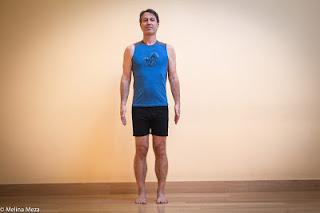 Start by coming into Mountain Pose (see Featured Pose: Mountain Pose ). Close your eyes and focus your attention on your posture and your breath for about a minute or as long as needed to center yourself.
Start by coming into Mountain Pose (see Featured Pose: Mountain Pose ). Close your eyes and focus your attention on your posture and your breath for about a minute or as long as needed to center yourself.2. Standing Cat-Cow Pose, 6 rounds.
This pose is simple way to warm up your spine for forward and backward bending poses.
In Mountain Pose, place your hands on your hips and bend your knees slightly while keeping your torso upright. On an inhalation, rock your pelvis forward, arch your spine up and let your chin rise gently. On your next exhalation, rock your pelvis backward, rounding your spine and bringing your chin gently towards your chest. The video above shows a seated version that you can use to understand how to practice the standing version.
After six rounds, return to Mountain Pose.
3. Arms Overhead Pose, dynamic (6 rounds) and static (30-60 seconds).
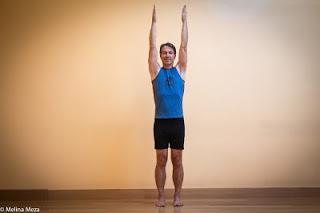
This pose is a good way to warm up your shoulders for poses where you’ll be keeping your arms overhead.
Starting in Mountain Pose, place a block between your thighs and firm your leg muscles to keep it in place. On an inhalation, raise your arms overhead. On your next exhalation, lower the arms back to your sides. The following video demonstrates the dynamic version of pose:
After six rounds, come into the static version of the pose for 30-60 seconds, lifting your arms strongly toward the sky, as you squeeze the block and you press your feet into the ground.
When you have finished, remove the block and return to Mountain Pose.
4. Dynamic Standing Forward Bend, 6 rounds.
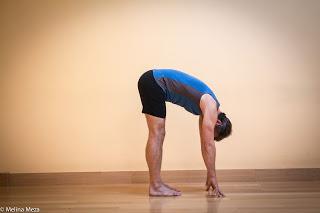 This pose an effective way to prepare for poses or sequences that involve deeper forward bending.
This pose an effective way to prepare for poses or sequences that involve deeper forward bending. Starting in Mountain Pose, on an inhalation, bring your arms overhead. On your next exhalation, release forward into Standing Forward Bend. From there, inhale and lift back up into Arms Overhead Pose with a slight backbend. Then exhale and release your arms back into Mountain Pose. This video provides instructions:
5. Crescent Moon Pose (Arms Overhead Pose, Version 4), dynamic (3-6 rounds) and static (3-6 breaths).
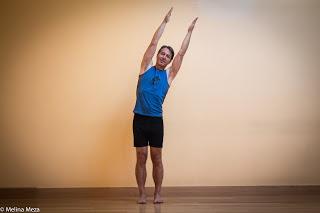
This pose a wonderful way to stretch and strengthen the sides of your body.
From Mountain Pose, on an inhalation, bring your arms overhead. On your next exhalation, arch to your right side into Crescent Moon pose and return to center on your inhalation. Now, exhale and bend to your left and return to center on your inhalation. Repeat for 3-6 more rounds, side to side, and then release into Mountain Pose. The following video provides instructions for practicing the dynamic version:
Now come into the static version of Crescent Moon Pose on the right side, reaching strongly diagonally up and over to the right, for 3-6 breaths. On an inhalation, return to center and repeat the pose on the left side.
When you’re finished, return to Mountain Pose.
6. Dynamic Goddess Pose, 6 rounds.
This pose, which typically appears in Moon Salutations, stretches and strengthens your hips and shoulders.
From Mountain Pose, step your feet about 3 feet apart, turning your feet out about 45 degrees. On an inhalation, come into Starfish Pose by raising your arms out to your sides, in line with your shoulders, palms facing down. On your next exhalation, keeping your spine upright, come into Goddess by bending your knees in the direction of your toes, stopping when your knees are over your ankles, and bending your elbows to raise your forearms to perpendicular with the floor and turning your palms to face each other. On your inhalation return to Starfish Pose, and repeat the sequence five more times. The video above provides instructions for practicing Dynamic Goddess Pose.
When you’re finished, return to Mountain Pose.
7. Eagle Pose Arms, 30-60 seconds per side.
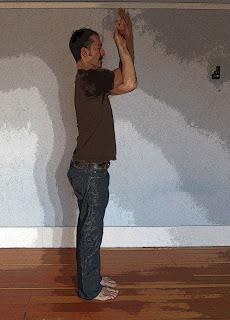 This pose stretches the muscles between your shoulder blades.
This pose stretches the muscles between your shoulder blades.From Mountain Pose, inhale and raise your arms up in front of you, parallel with the floor. Cross your right arm on top of your left arm so your right elbow is in the crook of your left elbow. Then bend your elbows so your forearms are perpendicular with the floor and your palms facing away from each other. You then have the option of hooking the fingers of your left hand around the heel of right hand.
Next, raise your upper arms to parallel with shoulders and draw your shoulder blades down your back as you press your elbows slightly forward. This video provides instructions on how to take the arm position (ignore the instructions for the legs):
When you're finished, release your arms to your sides and repeat with your left arm on top.
If full Eagle Pose arms is not accessible to you, see the two modifications described at Classic Static Warmup Poses.
8. Half Downward-Facing Dog, any version, 30-60 seconds.
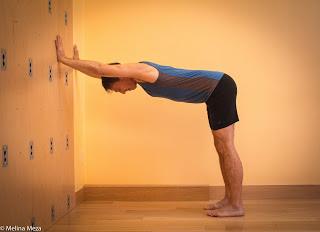 This version of Downward-Facing Dog Pose continues the opening you have already been cultivating in this sequence and is a good preparation for classic Downward-Facing Dog pose. See Featured Pose: Half Downward-Facing Dog Pose for instructions on how to enter, maintain, and come out of the from pose.
This version of Downward-Facing Dog Pose continues the opening you have already been cultivating in this sequence and is a good preparation for classic Downward-Facing Dog pose. See Featured Pose: Half Downward-Facing Dog Pose for instructions on how to enter, maintain, and come out of the from pose. Subscribe to Yoga for Healthy Aging by Email ° Follow Yoga for Healthy Aging on Facebook and Twitter ° To order Yoga for Healthy Aging: A Guide to Lifelong Well-Being, go to Amazon, Shambhala, Indie Bound or your local bookstore.
Follow Baxter Bell, MD on YouTube, Facebook, and Instagram. For upcoming workshops and retreatsee Baxter's Workshops and for info on Baxter see baxterbell.com.

